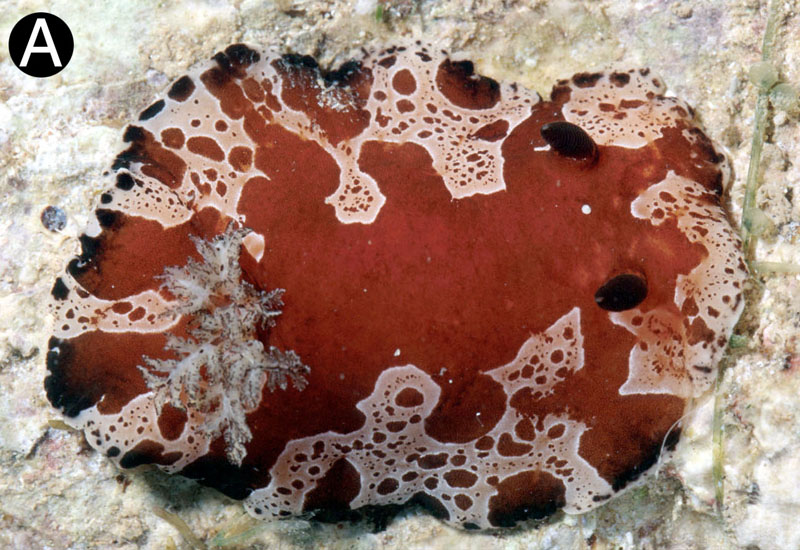 |
Platydoris dierythros
Fahey & Gosliner, 2003
A new species of Platydoris (Mollusca: Nudibranchia) from North-Western Australia
A new species of Platydoris Bergh, 1877 is described from the northwest coast of Western Australia. The new species Platydoris dierythros shares several characteristics with other species of Indo-Pacific Platydoris and clearly belongs to this genus. Those characters include a flat body shape, the dorsum covered by small caryophyllidia, a wide mantle margin, a two-part prostate, a penis armed with hooks, a lobate accessory gland, a smooth labial cuticle and hamate radular teeth. Other characters that distinguish this as a new species include the absence of vaginal hooks, fimbriate outer lateral teeth and the accessory gland positioned on the side of the deferent duct. The new species also shares some external color similarities with other tropical Indo-Pacific Platydoris .
The background color on the notum of this species is cream. There is a large, irregular blotch of bright red color that covers most of the dorsum. Nearer to the edge of the mantle are smaller, irregular blotches of the same color. Along the edge of the mantle are small, irregular black spots. These black spots are also found on the underside of the mantle, along the lateral edges, but not in the anterior ventral area. The rhinophores are maroon with a black club and white tip. The gill branches are white with black irregular markings. The ventral color is cream with dark blotches along the edge of the foot (Figure 1B). The oral tentacles are also cream.
Platydoris dierythros is readily distinguished by its bright red splashes of color covering the cream background of the dorsum. This bright red and cream color pattern that has overlaying black spots along the mantle edge is not found on any other Indo-Pacific species of Platydorididae. Although some species of Platydoris may have a bright red color on the dorsum such as the eastern Atlantic and Mediterranean species Platydoris argo (Linnaeus, 1767) , the background color in that species is not cream and there are no black spots along the mantle edge (Dorgan et al. 2002). Platydoris scabra (Cuvier, 1804) and P. cruenta (Quoy and Gaimard, 1832) can have a cream background color, but the irregular markings on the dorsum range from brown, to purple or gray on P. scabra (Dorgan et al. 2002). Platydoris cruenta can have red blotches on the dorsum, but there are accompanying wavy brown lines (Dorgan et al. 2002). Platydoris dierythros does not have these wavy brown lines. Platydoris formosa (Alder and Hancock, 1864) has a background color of whitish-cream with red blotches that are larger near the center of the body (Dorgan et al. 2002). But in this species the ventral side is white with numerous large, bright orange red spots on the border of the mantle. Platydoris dierythros has no colored spots on the ventral side, except for the dark spots along the foot and mantle borders. Platydoris herdmani , Farran, 1905, collected from Sri Lanka (Ceylon) has a single, pale reddish-brown blotch marked with darker spots on the dorsum, with smaller spots near the mantle margins. Along the mantle edge are sub-dermal black spots. The ventral side of this species has faint, pale brown dots and the margins of the foot have darker brown markings (Farran 1905).
The rhinophore and gill colors of Platydoris dierythros also differ from other similarly colored species of Platydoris. The rhinophores of Platydoris dierythros are maroon with a black club while those of Platydoris argo are darker than the body color and sometimes black, as is the gill (Dorgan et al. 2002). The rhinophores of P. scabra are yellow with dark orange tips and P. cruenta has rhinophores the same color as the dorsum and they are covered with brown lines. The gill of P. scabra is white with irregular dark lines on the rachises of the lamellae and the gill of P. cruenta is the same color or darker than the dorsum and covered with brown lines. Platydoris formosa has rhinophores that are uniformly red, with the tips slightly lighter. The gills of this species are cream with dark lines along the rachis.
In addition to the unique external color characters of Platydoris dierythros , there is a combination of internal anatomical features which sets this new species apart from other described Platydoris species.
Postdoctoral Fellow
Department of Invertebrate Zoology and Geology
California Academy of Sciences
Golden Gate Park
San Francisco, California 94118
Nov., 2003
Citation : Fahey, S. J. and Valdés, A. 2003. A new species of Platydoris (Mollusca: Nudibranchia) from Western Australia. in Wells, FE, Walker, DI and Jones, DS (eds). The marine flora and fauna of Dampier, Western Australia. Western Australian Museum, Perth.
Photo's courtesy of Terry Gosliner
Taxonomic text courtesy of Shireen Fahey
Circa 1998

Send Shireen email at sfahey@calacademy.org |
